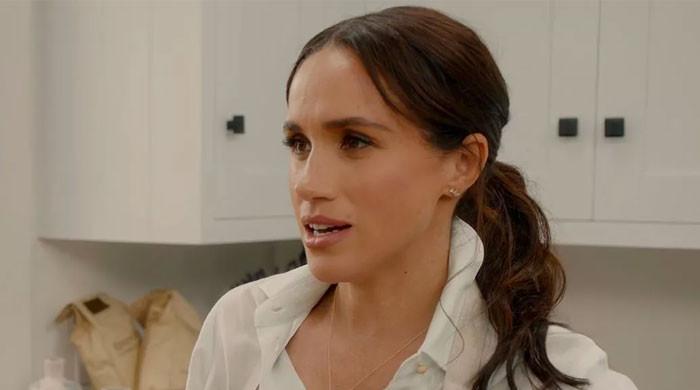Friends, I never thought I’d hear Sissy Spacek utter the words “Don’t drink my daughter’s pee if you can’t handle it, you freak!” And now that I have, I must say it was an absolute treat. The introduction of Spacek as Molly’s mother, Gail, is a needed catalyst that drives Molly’s repressed trauma out into the light. With 11 Academy Award nominations between them, Michelle Williams and Spacek are two women who know their way around drama and comedy, and the chemistry in their shared scenes is off the charts.
When Gail finally breezes into town, we see that she loves her daughter, but she’s far from a nurturing mother. It’s not Gail’s fault that she hasn’t shown up — Molly didn’t tell her that the cancer was back — but when she comes to town, she brings a whirlwind of chaos. We already know that a rift occurred between mother and daughter when Gail’s boyfriend sexually assaulted Molly when she was 7, but it’s clear that there were communication issues even prior to that horrific incident.

Gail parentified Molly at a young age, casting her in the role of the emotional caretaker (and likely often physical caretaker) of her mother, a woman who was struggling with addiction and mental-health issues. This established relationship has colored all other interactions in Molly’s life. Neither woman has been able to break free from these maladaptive patterns of behavior, so they’ve never been unable to talk about the sexual assault in any productive or healing way.
So, of course, when Gail arrives, she brings a ton of baggage with her. Gail’s appearance coincides with the one day that Nikki isn’t available to take Molly to chemotherapy, and her absence causes serious problems. While it seems like Molly doesn’t want to rock the boat and that she wants to foster a loving relationship with her mom, it’s also clear that she harbors crushing levels of resentment toward her.
“You once sent me to school with just a hot-dog bun for lunch,” her inner monologue hisses as the two women wait to be called into the chemo room. Gail is basically just an agent of bumbling chaos. She means well, but she’s mostly focused on her own plans and comfort without considering what Molly truly wants or needs.
They go to chemo, and in an anxiety-inducing sequence, Molly’s session becomes more and more crowded with visitors that Gail has invited without her daughter’s knowledge. First, a random cousin shows up as a part of a meal train with a dish that Molly can’t eat. Then, Steve pops in with a bag of bagels and cream cheese.
(Do these people even know how meal trains work? I’m thinking not.) And he’s brought along his new girlfriend for funsies! None of this is good for healing, and Molly copes by sinking farther under her glorious knit blanket, poison being pumped through her veins, frantically texting Nikki. When Nikki doesn’t answer, she invites her newest sexual conquest, her “pet,” a.
k.a. a guy whose kink is dressing in a dog costume and engaging in puppy play, to come snuggle with her for shock value.
Nikki, for her part, is distraught that she can’t be with Molly. Even in the throes of her post-dental-surgery drug haze, she only has Molly on her mind. But her sweet boyfriend Noah wants to give her a break for just one day.
So he turns her phone off. While Noah is understanding of Nikki’s situation, he’s still a person, and he understandably wants to have a little bit of his girlfriend’s attention. As a result of Noah’s deception, the couple breaks up.
Nikki is a true ride-or-die friend, but her all-encompassing focus on Molly is causing her to lose so many other things in her life. Is it worth it? Nikki certainly thinks so. For her part, Molly is getting to call (most of) the shots.
Her pet excitedly comes to her aid during the chemo debacle, and then later she fulfills one of his deepest fantasies: getting peed on. The physicality of this scene, the pet lying in the bottom of a tub with Molly’s leg sturdily propped up on one side as she trains her urine stream onto his body, presents a fascinating image. However, it also underscores the idea that Molly is delighted to give others what they might want, but she’s still nervous to ask someone for what she wants.
Gail barges into Molly’s apartment during the golden shower and blows up Molly’s spot in more ways than one. She reminds the pet that it’s not great that Molly has peed on him post-chemo. This somehow comes as a surprise to the guy, even though he was just literally snuggling with Molly while she got chemo, but whatever.
Everyone panics, and no one can open the pet’s collar. So, Molly has to call her neighbor to help, and Gail reveals to him that Molly has cancer. We’re going to get to him in a minute, but after everyone leaves, Molly and Gail have a showdown.
Molly tells her mother that when she’s around her, she feels like she’s broken. She’s having a hard time expressing what she wants to say because of “chemo brain,” but the two women reveal some hard truths. Gail’s memory of her daughter’s sexual assault is that it was a “hard moment” for her , so it’s clear that she’s not really considering Molly in the equation.
“I let him ruin you,” she says. Molly, for her part, says that she liked that the man chose her over her mother and that she even saw him put something in her mom’s drink and didn’t say anything. It’s in this moment that we find that Molly blames herself, her tiny, 7-year-old self, for this traumatic encounter, and it’s a devastating beat.
After Gail leaves, Molly walks back into her apartment building. The Neighbor Guy is waiting for her. She sweetly sidles up to the door, gently pressing the tip of her nose up against the glass and then sheepishly peeking her face around the side.
The two of them chat about her situation — Molly doesn’t want them to have a tragic love story — and all the neighbor asks is that she keeps kicking him in the dick. Molly happily agrees. Molly’s relationship with the Neighbor Guy — it feels like we’re not getting a name for him, so I’m just going to call him Guy from now on — is something that she has been shying away from ever since they spotted one another in the elevator.
Despite the fact that they’ve had several sexual encounters and he’s revealed to her some details of his sordid past, she isn’t the one to tell him about her cancer. She likes him, so she’s afraid to get close. But once Gail unintentionally lets the cat out of the bag, Molly allows herself to go all in.
One day, as they’re messing around, she tells him what she wants. She’s never orgasmed with another person, and she’d like to try with him. Guy is delighted.
“Happy Holidays” opens with Molly’s renewed sexual commitment to Guy, a man she really seems to like. They spend Thanksgiving together with butt plugs as a “special treat,” and then she begins to slowly let him explore her body. Unfortunately, even though she’s found a man who is eager to go on this journey with her, the memories of her past trauma haunt her.
Every time she begins to give herself in to pleasure, a faceless version of her abuser pops up, a reminder of how her very first sexual encounter, and the very first time a man told her he loved her, was a violation. She can’t let go because she’s frozen in a state of hypervigilance. But she’s going to keep trying.
In the cancer group, Sonya is trying something new. For the first step, she directs the group to write about something that scares them. Molly is able to complete this part of the prompt.
As she puts her memories to paper, she wrestles with her memories, imagining her numb 7-year-old self peeking at her from behind the shower curtain in the tub. Molly’s engagement with her younger self illustrates that her emotional development was frozen in a lot of ways at that moment, but it also suggests that she feels responsible for working on resolving the emotional distress that it’s caused her. How does she make things right for the 7-year-old version of herself? Molly wonders if reading her memory out loud will cure her.
It doesn’t. Later, Sonya works on the second step of the process. She asks the group members to move their bodies in any way they’d like as another person reads their story aloud.
Initially, this seems silly to the group, but then one of the women begins to engage. She experiences some catharsis as she wiggles and whirls around, physically freeing the stress and tension that her words and thoughts have trapped inside her ailing body. These types of treatments aren’t a cure-all, but the idea of physical movement releasing trapped responses inside the body is something that some trauma-focused therapies do concentrate on.
In fact, one of the steps of the Trauma Resiliency Model focuses on “completion of survival responses,” which is helping individuals physically move the way they may have wanted to, or even the way they did, during a traumatic incident. When we finally see Molly complete this exercise, she certainly incorporates elements of this type of response. First, however, we see Molly put up a lot of resistance to the movement part of Sonya’s prompt.
As a therapist myself, I have seen a lot of confusion or pushback to engaging in therapies like these. In our cerebral society, we don’t put much of a premium on connecting with our bodies in an emotional way. When we put ourselves out there physically, it can feel like we’re exposing ourselves to more trauma in the form of judgement or ridicule, but under the right circumstances, a physical release can be transcendent.
However, Molly doesn’t really get a chance to work through those particular fears in her group session because her leg is swollen: She has deep-vein thrombosis, necessitating a long stay in the hospital over Christmas. This physical setback also sets Molly back mentally. Her goal was to orgasm by Christmas, and she feels like she’s failed.
So, instead of leaning on Nikki and Guy, the people who love her, for support, she seeks out a random dude to jerk off on New Year’s Eve. This does not go well, and she returns to Nikki to apologize. Dying for Sex works on illustrating that Molly’s cathartic emotional release is tied to Molly’s search for a cathartic sexual release, and the sequence in which Molly finally finds a safe space to fully be vulnerable about her trauma is absolutely beautiful.
Molly admits to Nikki that she thinks it was her fault, saying, “I tried to hold his hand, and he told me to stop being a child.” Nikki’s response, “And you did. You did stop being a child,” underscores the awful truth and provides a much-needed opening for Molly.
Instead of verbally responding to Nikki’s insight, Molly begins to move her body, letting it do what it needs to let go. In an astounding sequence of physicality, Molly punches, spins, flails, gasps, laughs, and dances her way to acceptance as her friend bears witness to her catharsis. Michelle Williams sells every movement, every breath as she throws her entire being into Molly’s release.
The scene is brief, but more than once I wondered who, if anyone, choreographed this sequence, or if they just let Williams follow her instincts. Either way, it’s a gorgeous testament to how much we gain when we turn our focus outward and invite the body to join the brain in the process of healing. For some reason, it’s not until months later that Molly runs into Guy on the street.
Why hasn’t she called him? It’s unclear. But they chat for a moment, with Guy musing that he’s never seen her outside, and then they go their separate ways. But then Molly collapses, and Guy races to her side, calling 911.
They lie together on the sidewalk, hands clasped, and as they wait for help, they profess their love for one another. It doesn’t seem like Molly has much time left, but hopefully she’ll make the most of it with an open heart and an open mind. By submitting your email, you agree to our Terms and Privacy Notice and to receive email correspondence from us.
.
Entertainment

Dying for Sex Recap: Let’s Get Physical

I never thought I’d hear Sissy Spacek utter the words, “Don’t drink my daughter’s pee if you can’t handle it, you freak!”














